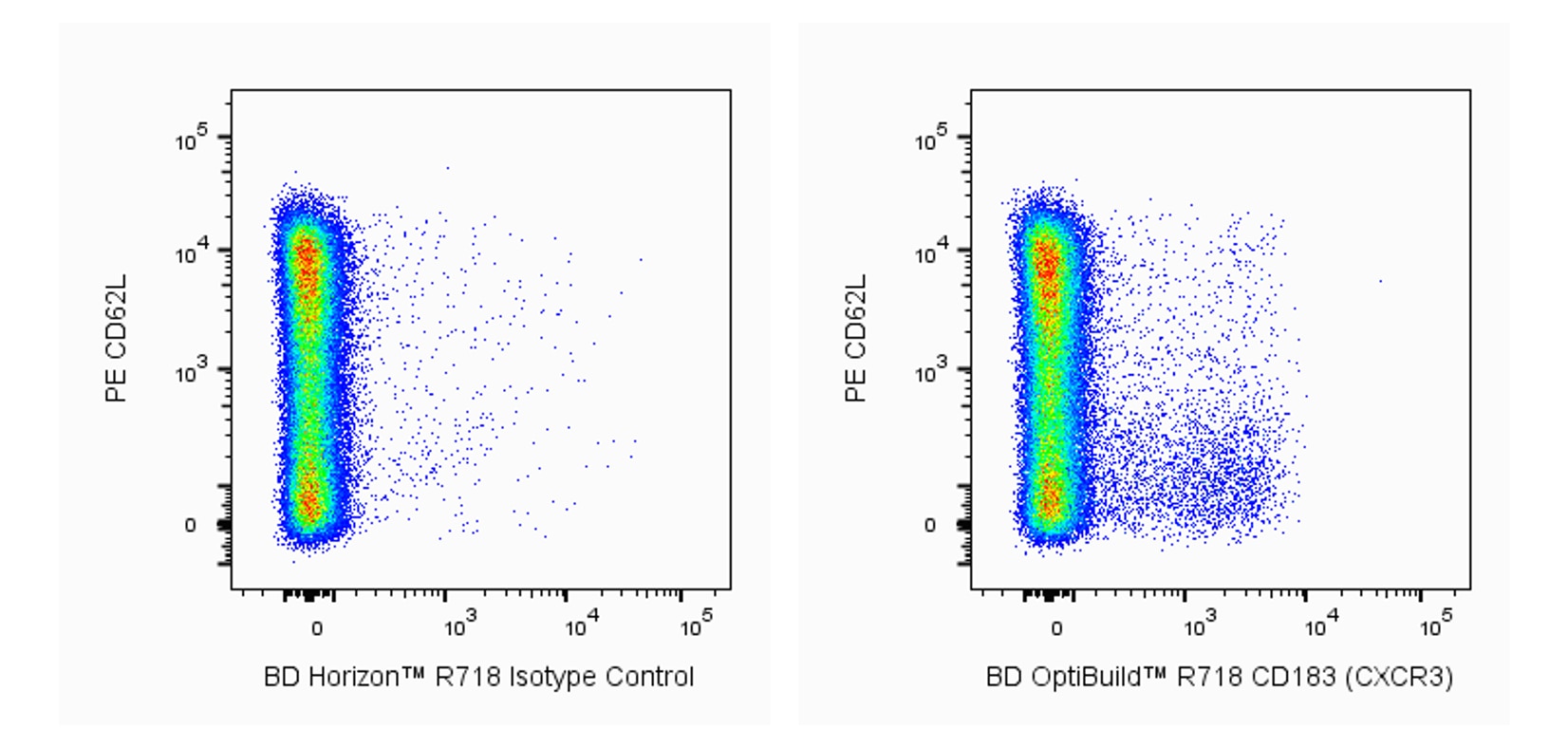-
Your selected country is
Middle East / Africa
- Change country/language
Old Browser
This page has been recently translated and is available in French now.
Looks like you're visiting us from {countryName}.
Would you like to stay on the current country site or be switched to your country?


.png)

Multiparameter flow cytometric analysis using BD OptiBuild™ R718 Hamster Anti-Mouse CD183 (CXCR3) antibody (Cat. No. 752155; Right Plot) on viable C57BL/6 Mouse splenocytes, with corresponding IgG Isotype Control (Cat. No. 566951; Left Plot). Flow cytometry was performed using a BD LSRFortessa™ X-20 Flow Cytometer System.
.png)

BD OptiBuild™ R718 Hamster Anti-Mouse CD183 (CXCR3)
.png)
Regulatory Status Legend
Any use of products other than the permitted use without the express written authorization of Becton, Dickinson and Company is strictly prohibited.
Preparation And Storage
Recommended Assay Procedures
BD® CompBeads can be used as surrogates to assess fluorescence spillover (compensation). When fluorochrome conjugated antibodies are bound to BD® CompBeads, they have spectral properties very similar to cells. However, for some fluorochromes there can be small differences in spectral emissions compared to cells, resulting in spillover values that differ when compared to biological controls. It is strongly recommended that when using a reagent for the first time, users compare the spillover on cells and BD® CompBeads to ensure that BD® CompBeads are appropriate for your specific cellular application.
Product Notices
- The production process underwent stringent testing and validation to assure that it generates a high-quality conjugate with consistent performance and specific binding activity. However, verification testing has not been performed on all conjugate lots.
- Please refer to www.bdbiosciences.com/us/s/resources for technical protocols.
- Since applications vary, each investigator should titrate the reagent to obtain optimal results.
- An isotype control should be used at the same concentration as the antibody of interest.
- Caution: Sodium azide yields highly toxic hydrazoic acid under acidic conditions. Dilute azide compounds in running water before discarding to avoid accumulation of potentially explosive deposits in plumbing.
- For fluorochrome spectra and suitable instrument settings, please refer to our Multicolor Flow Cytometry web page at www.bdbiosciences.com/colors.
- Please refer to http://regdocs.bd.com to access safety data sheets (SDS).
- This product is provided under an Agreement between BIOTIUM and BD Biosciences. This product, and only in the amount purchased by buyer, may be used solely for buyer’s own internal research, in a manner consistent with the accompanying product literature. No other right to use, sell or otherwise transfer (a) this product, or (b) its components is hereby granted expressly, by implication or by estoppel. This product is for research use only. Diagnostic uses require a separate license from Biotium, Inc. For information on purchasing a license to this product including for purposes other than research, contact Biotium, Inc., 3159 Corporate Place, Hayward, CA 94545, Tel: (510) 265-1027. Fax: (510) 265-1352. Email: btinfo@biotium.com.
- Alexa Fluor™ is a trademark of Life Technologies Corporation.
- For U.S. patents that may apply, see bd.com/patents.
Companion Products




.png?imwidth=320)
The CXCR3-173 monoclonal antibody specifically binds to mouse CD183, also known as CXCR3. CD183 is a seven transmembrane spanning, G protein-coupled chemokine receptor for CXC chemokines including CXCL9 (Mig), CXCL10 (IP-10) and CXCL11 (I-TAC). These chemokines are induced by inflammatory cytokines including IFN-γ, IFN-α/β, and TNF. CXCR3 is primarily expressed on activated/memory CD4+ and CD8+ T lymphocytes, Foxp+ regulatory T cells, natural killer T (NKT) cells and mature NK cells. Binding of chemokines to CXCR3 induces integrin activation, cytoskeletal changes, and chemotactic migration of activated lymphocytes. CD183 has been reported to play important roles in T cell recruitment and immune responses in a number of inflammatory and autoimmune diseases. The CXCR3-173 antibody reportedly inhibited in vitro chemotactic responses to CXCL10 or CXCL11 significantly but not to CXCL9. When administered systemically to mouse hosts, the CXCR3-173 antibody reportedly prolonged cardiac and pancreatic islet cell allograft survival. In the presence of CXCR3 ligands, especially, CXCL10 and CXCL11, staining with the antibody can be significantly blocked.

Development References (4)
-
Krug A, Uppaluri R, Facchetti F, et al. IFN-producing cells respond to CXCR3 ligands in the presence of CXCL12 and secrete inflammatory chemokines upon activation. J Immunol. 2002; 169(11):6079-6083. (Biology). View Reference
-
Soto H, Wang W, Strieter RM, et al. The CC chemokine 6Ckine binds the CXC chemokine receptor CXCR3. Proc Natl Acad Sci U S A. 1998; 95(14):8205-8210. (Biology). View Reference
-
Tamaru M, Tominaga Y, Yatsunami K, Narumi S. Cloning of the murine interferon-inducible protein 10 (IP-10) receptor and its specific expression in lymphoid organs. Biochem Biophys Res Commun. 1998; 251(1):41-48. (Biology). View Reference
-
Uppaluri R, Sheehan KC, Wang L, et al. Prolongation of cardiac and islet allograft survival by a blocking hamster anti-mouse CXCR3 monoclonal antibody. Transplantation. 2008; 86(1):137-147. (Immunogen: Flow cytometry, Functional assay, Inhibition, In vivo exacerbation). View Reference
Please refer to Support Documents for Quality Certificates
Global - Refer to manufacturer's instructions for use and related User Manuals and Technical data sheets before using this products as described
Comparisons, where applicable, are made against older BD Technology, manual methods or are general performance claims. Comparisons are not made against non-BD technologies, unless otherwise noted.
For Research Use Only. Not for use in diagnostic or therapeutic procedures.
Report a Site Issue
This form is intended to help us improve our website experience. For other support, please visit our Contact Us page.